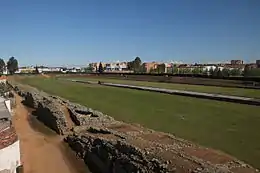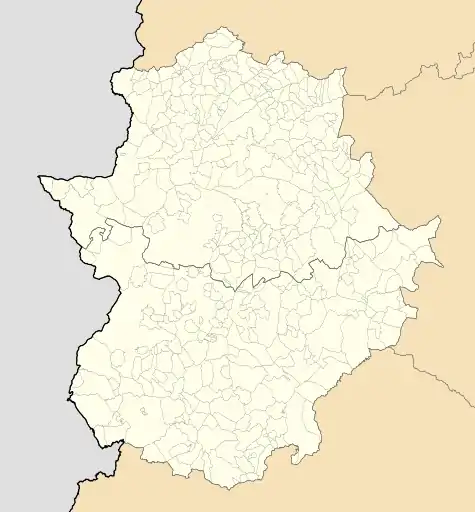Roman circus of Mérida
The Roman circus of Mérida (Spanish: Circo romano) is a ruined Roman circus in Mérida, Spain. Used for chariot racing, it was modelled on the Circus Maximus in Rome and other circus buildings throughout the empire. Measuring more than 400 m in length and 30 m of width, it is one of the best preserved examples of the Roman circus.[1] It could house up to 30,000 spectators.
| UNESCO World Heritage Site | |
|---|---|
 View of the Roman circus from the roof of the adjacent museum | |
| Location | Mérida, Province of Badajoz, Extremadura, Spain |
| Part of | Archaeological Ensemble of Mérida |
| Criteria | Cultural: (iii)(iv) |
| Reference | 664-010 |
| Inscription | 1993 (17th session) |
| Area | 5.9935 ha (14.810 acres) |
| Buffer zone | 20.87 ha (51.6 acres) |
| Coordinates | 38°54′58″N 6°20′16″W |
 Location of Roman circus of Mérida in Extremadura  Roman circus of Mérida (Spain) | |
History
There is no consensus about the circus' dating, as it was built and used for several years before its official dedication. It seems to have been built sometime around 20 BC and inaugurated some 30 years later. It was located far outside the city walls, but close to the road that connected the city to Toledo and Córdoba.
After the fall of the Western Roman Empire, and the rise of Christianity in Spain, the circus saw more use than the other Roman structures of Mérida, since racing was considered less sinful than spectacles performed in the theatre and amphitheater.[2]
Modern status
Mérida's circus remains very well preserved. As is true with the Circus Maximus, most circuses's structures have been destroyed over time as the area occupied by them was great and often in very flat land near their respective cities. The Mérida circus however has kept numerous structures, including the Porta Pompae ("main entrance"), the Porta Triumphalis ("triumph gate"), the spina (the longitudinal wall), the tribunal iudicium ("tribune of the judges").
A museum dedicated to the circus now sits near the middle edge of the circus grounds and allows admittance into the fenced area around the circus remains.
See also
References
| Wikimedia Commons has media related to Ancient Roman circus of Mérida. |
- "Roman Circus of Merida". Spanisharts.com. Retrieved 12 August 2018.
